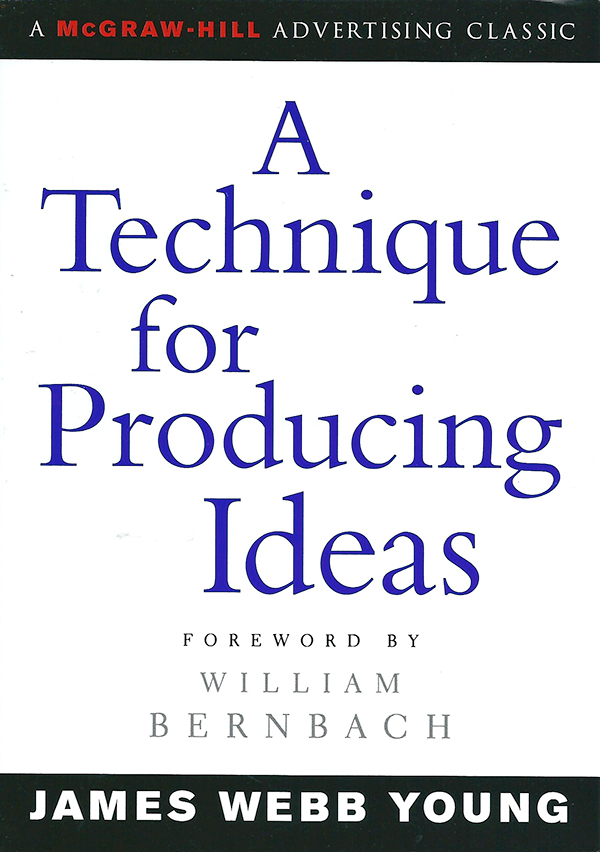The Book in Three Sentences
An idea occurs when you develop a new combination of old elements. The capacity to bring old elements into new combinations depends largely on your ability to see relationships. All ideas follow a five-step process of 1) gathering material, 2) intensely working over the material in your mind, 3) stepping away from the problem, 4) allowing the idea to come back to you naturally, and 5) testing your idea in the real world and adjusting it based on feedback.
A Technique for Producing Ideas summary
This is my book summary of A Technique for Producing Ideas by James Webb Young. My notes are informal and often contain quotes from the book as well as my own thoughts. This summary also includes key lessons and important passages from the book.
- The quality of your work (and life) is a result of all the forces that have played upon you throughout life. The goal is to make the most of those forces.
- In learning anything, first you should learn the principles, then you should learn the method.
- Particular bits of knowledge are just “rapidly aging facts.” What matters are the underlying principles and methods.
- You can know every fact about an industry and still not be a real expert because you don’t understand the underlying principles and methods.
- What is most valuable to know is not where to look for a particular idea, but how to train the mind in the method by which all ideas are produced; and how to grasp the principles which are at the source of all ideas.
- An idea is nothing more or less than a new combination of old elements.
- The capacity to bring old elements into new combinations depends largely on the ability to see relationships.
- What is the one word which will best arouse the emotion with which I wish this particular advertisement to be charged?
- The habit of searching for relationships between facts becomes of the highest importance in the production of ideas.
- Books on social psychology are often better books about advertising than actual books on advertising.
- There are five critical steps that everyone follows whenever they produce a new idea.
- Step 1: gather new material. This includes specific material (related to the product or task) and general material (fascination with a wide range of concepts).
- Step 2: work over the materials in your mind. Mentally “chew” your new material by looking at the facts from different angles and experimenting with fitting ideas together.
- Step 3: put the problem completely out of your mind and go do something else that excites you and energizes you.
- Step 4: your idea will come back to you with a flash of insight, only after you have stopped straining.
- Step 5: shape and develop your idea into practical usefulness. Put your idea out into the world, submit it to criticism, and adapt it as needed.
- On getting intimate knowledge of a product: most people stop too soon. If the surface differences are not striking, we assume that there are no differences. But if we go deeply enough, or far enough, we nearly always find that between every product and some consumers there is an individuality of relationship which may lead to an idea.
- The greatest way to develop general knowledge on a subject is to get genuinely interested in something. Living in a curious way and becoming fascinated with things is a fantastic way to live and it will ensure you never run out of ideas.
- The more general knowledge you have, the more opportunity you have for creating new relationships and connections between ideas.
- In advertising, an idea results from a new combination of specific knowledge about products and people with general knowledge about life and events.
- A great many ideas are lost in the final stage. The idea man, like the inventor, is often not patient enough or practical enough to go through with adapting his ideas to fit the actual conditions of the world.
- Good ideas have self-expanding qualities. When someone sees it, they naturally tell you what should be added and how to make it better.
- If your idea is good, people will tell you how to improve it. Listen to them. Don’t hold the initial version too close to your chest.
- There are some advertisements you just cannot write until you have lived long enough. The cycle of years does something to fill your reservoir, unless you refuse to live spatially and emotionally.
- The central idea of the book reminds me of the Robert Frost quote, “An idea is a feat of association, and the height of it is a good metaphor.”
Reading Suggestions
This is a list of authors, books, and concepts mentioned in A Technique for Producing Ideas, which might be useful for future reading.
- The Art of Thought by Graham Wallas
- Science and Method by H. Poincare
- The Art of Scientific Investigation by W.I.B. Beveridge
